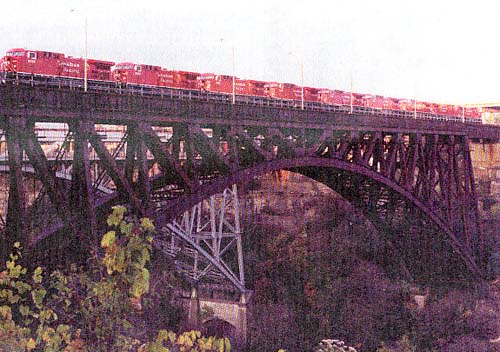|
Bridge Sale Prepares Way for
Canada-US Trade
Growth

This steel-arched Niagara landmark will help alleviate congestion at the Canada/US border
when converted to truck traffic.
Niagara Falls
Ontario - A new international freight transportation route dedicated to heavy trucks took a step closer to reality with the recent
announcement that a bi-national business partnership will purchase the former Niagara River bridge between this city and its counterpart
in New York State.
"Looking ahead five years, we see the day when a dedicated three lane roadway over the former railway bridge will expedite truck
traffic and alleviate growing congestion at this border crossing", said William H. Truesdale, president Whirlpool International
Bridge (U.S.A.) Inc.
Along with a related Canadian company, WITB has agreed to purchase the bridge from the Canada Southern Railway company (CASO) for
$19.8-million. CASO is jointly owned by CN and CPR.
The proposed US$220-million redevelopment of the bridge and approaches is expected to take five years, including public and regulatory
review and approval prior to the construction phase. The purchase is expected to close next year.
Rising 75 metres above the Niagara River, the steel-arch bridge was built for the Michigan Central Railway in the early 1920s and opened
for traffic in 1925. Some 215 metres of its 378-metre length are in the United States, with the remaining 163 metres in Canada.
After several ownership changes it was purchased in 1985 along with other CASO assets by CN and CPR. It formed part of a CPR international
gateway route until 19 Dec 2001.
That's when CN and CPR, along with city and Ontario government officials held a ceremony in Niagara Falls to mark the rerouting of freight
trains from the eastern approach to the bridge through the city's busy tourist area.
No Track Downtown
Niagara Falls and the Ontario Lottery and Gaming Corp. had bought the line following a trackage rights agreement between the two
railways, which allowed the rerouting of CPR trains to the international CN route via Fort Erie.
Removal of 6.6-miles (10.7 kilometres) of downtown track was an important step in allowing the city to take the lead in redevelopment of
prime real estate. Local CPR freight trains continue to serve industries located in the south end of Niagara Falls, while the efficiency
of its international route has improved.
|